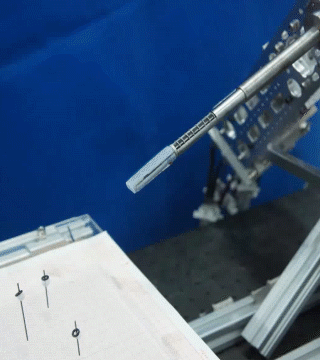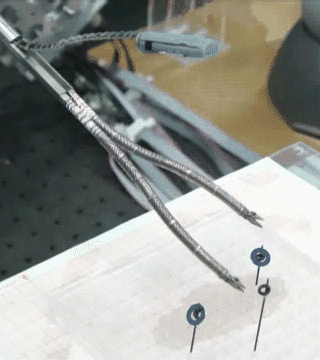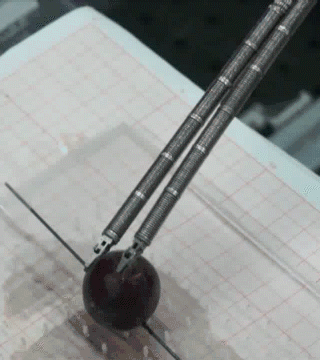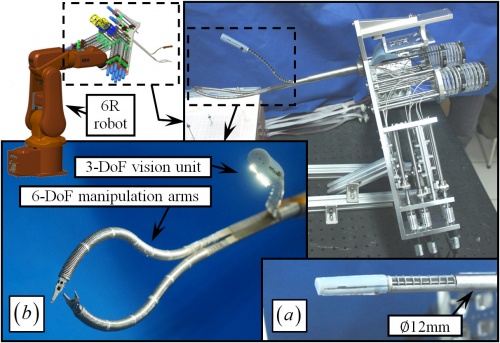From Rii
| (5 intermediate revisions not shown) | |||
| Line 1: | Line 1: | ||
{{DISPLAYTITLE:<span style="display:none">{{FULLPAGENAME}}</span>}} | {{DISPLAYTITLE:<span style="display:none">{{FULLPAGENAME}}</span>}} | ||
| - | = A Robotic | + | = A SJTU Unfoldable Robotic System for Single Port Laparoscopy = |
September 2011 to present | September 2011 to present | ||
[[image:note_bulb.png|text-bottom|12px]] This work was supported by [http://www.sait.samsung.co.kr/ the Samsung Advanced Institute of Technology (SAIT)] under [http://www.sait.samsung.co.kr/saithome/01_about/gro_overview.jsp the Global Research Outreach (GRO) program]. | [[image:note_bulb.png|text-bottom|12px]] This work was supported by [http://www.sait.samsung.co.kr/ the Samsung Advanced Institute of Technology (SAIT)] under [http://www.sait.samsung.co.kr/saithome/01_about/gro_overview.jsp the Global Research Outreach (GRO) program]. | ||
| - | [[File: Research_SAIT_SPA2011_1.jpg|thumb| | + | [[File: Research_SAIT_SPA2011_1.jpg|thumb|300px|Schematic of a surgical robot for Single Port Laparoscopy (SPL)]] |
| - | + | Single Port Laparoscopy (SPL) might bring better surgical outcomes than traditional multi-port laparoscopy, in terms of postoperative pain, complications, hospitalization time, cosmesis, etc. Due to the increased manipulation difficulty in SPL, several surgical robotic systems were developed, including [[Research_IREP2007|the IREP robot]] which was designed by Dr. Kai Xu when he was with the Advanced Robotics & Mechanism Applications Lab, Department of Mechanical Engineering, Columbia University. | |
| - | + | This project focuses on the design and implementation of a teleoperative robot, the SJTU Unfoldable Robotic System (SURS), for SPL, pushing the design boundary of SPL robots. | |
| - | + | As shown in the picture, the SURS could be carried and positioned by a standard 6R industrial robot. The industrial robot acts as a RCM (Remote Center of Motion) mechanism and pivots the stem of the SURS around the incision point in the abdomen wall. | |
| - | + | ||
| - | + | ||
| - | + | ||
| - | + | [[File: Research_SAIT_SPA2011_2.jpg|thumbnail|left|500px|The SURS robot: (a) the folded configuration with an outer diameter of 12mm, and (b) the unfolded working configuration]] | |
| - | [[File: Research_SAIT_SPA2011_2.jpg| | + | |
| + | Once positioned by the 6R robot, the SURS can be deployed into abdomen through a ∅12mm skin incision in the folded configuration and can then be unfolded to form a dual-arm working configuration. It consists of two 6-DoF manipulation arms and one 3-DoF vision unit. | ||
| + | |||
| + | The SURS’s control infrastructure adopts a conventional setup for teleoperation. Two Phantom Omni devices were connected to a Host PC via IEEE 1394 firewires to provide control inputs. The Host PC runs a Windows-based program that sends the tip positions and orientations from the two Omni devices to two Target PCs via a router with LAN connections using a UDP every 10 milliseconds. Each Target PC controls one manipulation arm under a real-time OS generated by MATLAB’s xPC module. The duration of the servo loop is 1 millisecond. | ||
| + | |||
| + | Compared to [[Research_IREP2007|the IREP robot]], main improvements featured by the SURS include i) a reduced diameter of the access port, ii) an enhanced distal dexterity, and iii) an improved payload capability introduced by the modified continuum structure of the manipulation arms. | ||
| + | |||
| + | SURS's functionality can be seen from the video clips below, including the deployment, pick-and-place, tissue peeling, knot tying and tissue resection. | ||
| + | |||
| + | {|border="1" align="center" cellpadding="5" | ||
| + | |[[Image: Research_SAIT_SPA2011_3.gif]] | ||
| + | |[[Image: Research_SAIT_SPA2011_4.gif]] | ||
| + | |[[Image: Research_SAIT_SPA2011_5.gif]] | ||
| + | |- | ||
| + | |colspan="2" align="center"|[[Image: Research_SAIT_SPA2011_6.gif]] | ||
| + | |[[Image: Research_SAIT_SPA2011_7.gif]] | ||
| + | |} | ||
Latest revision as of 04:07, 6 October 2014
A SJTU Unfoldable Robotic System for Single Port Laparoscopy
September 2011 to present
![]() This work was supported by the Samsung Advanced Institute of Technology (SAIT) under the Global Research Outreach (GRO) program.
This work was supported by the Samsung Advanced Institute of Technology (SAIT) under the Global Research Outreach (GRO) program.
Single Port Laparoscopy (SPL) might bring better surgical outcomes than traditional multi-port laparoscopy, in terms of postoperative pain, complications, hospitalization time, cosmesis, etc. Due to the increased manipulation difficulty in SPL, several surgical robotic systems were developed, including the IREP robot which was designed by Dr. Kai Xu when he was with the Advanced Robotics & Mechanism Applications Lab, Department of Mechanical Engineering, Columbia University.
This project focuses on the design and implementation of a teleoperative robot, the SJTU Unfoldable Robotic System (SURS), for SPL, pushing the design boundary of SPL robots.
As shown in the picture, the SURS could be carried and positioned by a standard 6R industrial robot. The industrial robot acts as a RCM (Remote Center of Motion) mechanism and pivots the stem of the SURS around the incision point in the abdomen wall.
Once positioned by the 6R robot, the SURS can be deployed into abdomen through a ∅12mm skin incision in the folded configuration and can then be unfolded to form a dual-arm working configuration. It consists of two 6-DoF manipulation arms and one 3-DoF vision unit.
The SURS’s control infrastructure adopts a conventional setup for teleoperation. Two Phantom Omni devices were connected to a Host PC via IEEE 1394 firewires to provide control inputs. The Host PC runs a Windows-based program that sends the tip positions and orientations from the two Omni devices to two Target PCs via a router with LAN connections using a UDP every 10 milliseconds. Each Target PC controls one manipulation arm under a real-time OS generated by MATLAB’s xPC module. The duration of the servo loop is 1 millisecond.
Compared to the IREP robot, main improvements featured by the SURS include i) a reduced diameter of the access port, ii) an enhanced distal dexterity, and iii) an improved payload capability introduced by the modified continuum structure of the manipulation arms.
SURS's functionality can be seen from the video clips below, including the deployment, pick-and-place, tissue peeling, knot tying and tissue resection.

| 
| 
|

| 
| |

